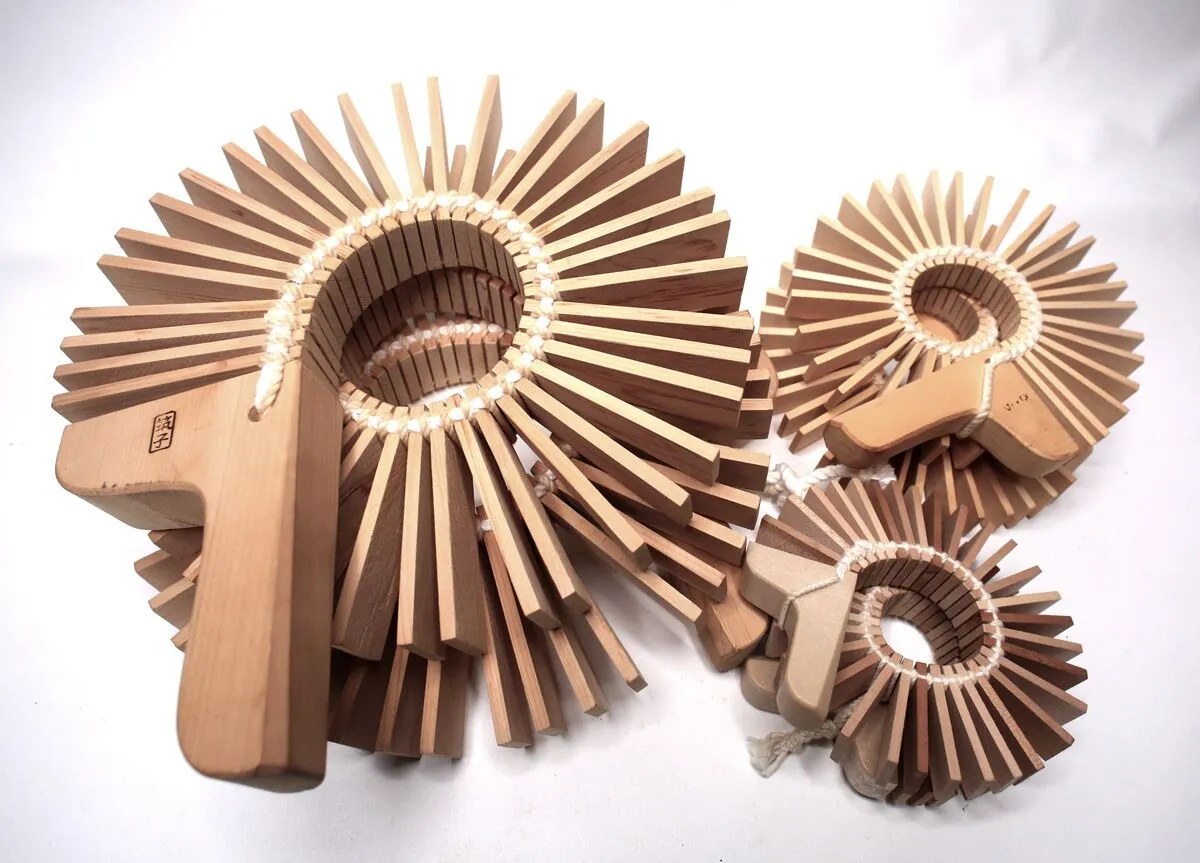Binzasara
Percussions
Asia
Between 1001 and 1900 AD
Video
The Binzasara, also known as the Kokiriko, is a traditional Japanese percussion instrument primarily used in folk music and dance performances. It belongs to the category of idiophones, meaning it produces sound through the vibration of its own material rather than relying on strings, membranes, or air columns. The instrument is crafted from a series of wooden slats strung together with a strong cord or leather strap, allowing them to flex and produce a distinctive rattling or clattering sound when shaken or manipulated by hand. The slats are often made from bamboo or other lightweight wood, ensuring both durability and resonance.
Binzasara is often associated with traditional Japanese music but has also found applications in modern compositions and performances due to its unique timbre and rhythmic capabilities. It is primarily played by gripping the handles on both ends and moving them in a wave-like motion, which causes the wooden slats to strike each other and produce rhythmic clattering sounds. The instrument is valued for its simplicity and effectiveness in adding texture to musical compositions.
History and Origin
The Binzasara originates from Asia, specifically from Japan. While the concept of rattling instruments exists in various cultures, the Binzasara has remained uniquely tied to Japanese folk traditions and is rarely found outside the region in its traditional form. The exact origins of the Binzasara are difficult to pinpoint, but it is believed to have emerged during the Edo period (17th–19th century) in Japan. This was a time of significant artistic and cultural development, with traditional music and performance arts flourishing. Many folk instruments, including the Binzasara, became integral to regional celebrations, religious rituals, and entertainment.
Types and Features
The Binzasara does not have extensive variations like other musical instruments, but there are a few distinctions based on construction and usage.
Traditional Binzasara: The most common type, made from numerous wooden slats connected by a strong cord. It is used in folk music and religious ceremonies.
Modern Adaptations: Some variations of the Binzasara are designed for contemporary musical compositions and performances, incorporating different materials or slightly altered structures for improved durability and sound quality.
The key features of the Binzasara include:
Material: Usually crafted from bamboo or hardwood, ensuring a distinct resonant sound.
Structure: Consists of numerous small slats, typically numbering between 30 to 50, linked by a strong cord or strap.
Sound Mechanism: Produces a rhythmic clattering sound when moved in a controlled manner.
Size: Generally small and portable, making it easy to handle and transport.
Work Mechanics
The Binzasara is played by holding the handles attached to either end of the instrument and moving them in a wavelike motion. This action causes the slats to knock against one another, creating a distinctive percussive sound. The dynamics of the sound can be controlled by adjusting the speed and intensity of the movement, making it a versatile tool for rhythm creation.
The performer grips both ends and moves their hands in opposite directions to create a rippling effect through the slats. The sound can be manipulated by changing the angle, speed, or force of the movement. The Binzasara is often used in combination with other traditional Japanese instruments, providing a rhythmic backdrop or accentuating key musical phrases.
Role in Music
The Binzasara is primarily used as a rhythmic instrument, playing a supporting role in many traditional Japanese music ensembles. It is most commonly found in folk performances, where its distinctive clattering sound adds depth and texture to musical arrangements.
Folk and Traditional Music: The Binzasara is often played in festivals and religious ceremonies, complementing the sounds of other traditional instruments such as the taiko drum and shamisen.
Dance Accompaniment: It is frequently used to enhance rhythmic patterns in folk dances, providing an engaging auditory experience for both performers and audiences.
Modern Musical Incorporation: In contemporary settings, musicians sometimes incorporate the Binzasara into experimental and fusion music, blending traditional sounds with modern genres.
Significance of Binzasara (Kokiriko) Musical Instrument
The Binzasara holds cultural and musical significance, particularly in the realm of Japanese folk traditions. Its importance can be examined in the following aspects:
The instrument serves as a vital link to Japan’s musical heritage, ensuring that traditional sounds and practices continue to be passed down through generations. The Binzasara is often associated with celebratory events and religious rituals, symbolizing joy, unity, and tradition. It is widely used in schools and cultural programs to teach rhythm and traditional Japanese music to younger generations. Beyond its musical function, the Binzasara is often appreciated for its handcrafted beauty and craftsmanship, reflecting the artistry involved in Japanese instrument-making.
The Binzasara is a simple yet impactful instrument with a rich history and cultural importance. While primarily used in traditional Japanese music, it continues to be a cherished instrument in both historical and modern musical contexts. Its unique sound and straightforward mechanics make it a valuable addition to the world of percussive instruments, ensuring its enduring presence in musical traditions.
FAQ
What type of instrument is the Binzasara?
The Binzasara is a traditional Japanese percussion instrument. It is known for its distinctive sound and versatility in various musical genres.
What are some notable features of the Binzasara?
The Binzasara features small wooden pieces held together by a fabric or cotton cord, allowing for a variety of sounds and rhythms. It is versatile and can be played in different musical contexts.
What materials are used to make the Binzasara?
The Binzasara is typically made from hardwoods like maple or oak for the wooden pieces, and a strong, flexible fabric or cotton cord to hold them together.
 Links
Links
References
Other Instrument
Categories


















